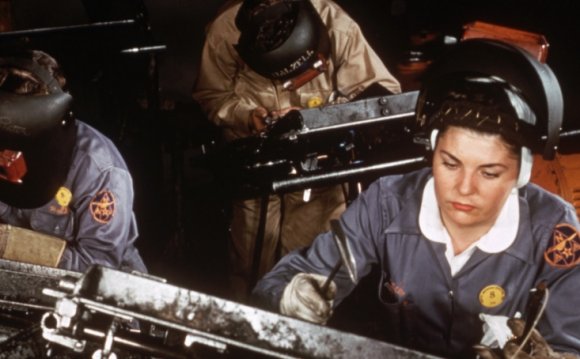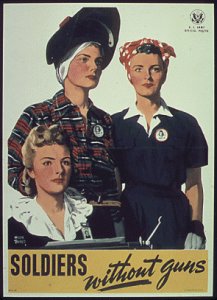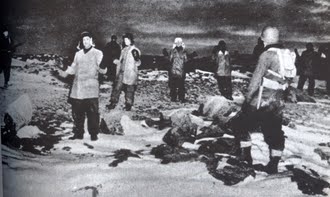
 World War II had a profound impact on the United States. Although no battles occurred on the American mainland, the war affected all phases of American life. It required unprecedented efforts to coordinate strategy and tactics with other members of the Grand Alliance and then to plunge into battle against the Axis powers—Germany, Italy, and Japan. At the same time, it demanded a monumental production effort to provide the materials necessary to fight. As the United States produced the weapons of war and became, in President Franklin D. Roosevelt’s phrase, the “arsenal of democracy, ” the country experienced a fundamental reorientation of economic and social patterns at home that provided the template for the postwar years.
World War II had a profound impact on the United States. Although no battles occurred on the American mainland, the war affected all phases of American life. It required unprecedented efforts to coordinate strategy and tactics with other members of the Grand Alliance and then to plunge into battle against the Axis powers—Germany, Italy, and Japan. At the same time, it demanded a monumental production effort to provide the materials necessary to fight. As the United States produced the weapons of war and became, in President Franklin D. Roosevelt’s phrase, the “arsenal of democracy, ” the country experienced a fundamental reorientation of economic and social patterns at home that provided the template for the postwar years.
In the economic arena, the war ended the Great Depression. Military spending that began in 1940 to bolster the defense effort gave the nation’s economy the boost it needed, and millions of unemployed Americans returned to work to make the weapons of war needed to protect the United States. The renewed prosperity vindicated the theory of English economist John Maynard Keynes, who had earlier argued that sizable government spending could end a depression if the private sector was unable or unwilling to engage in such spending itself.
Mobilization required enormous organizational adjustments. The nation worked closely with businessmen, for, as Secretary of War Henry L. Stimson observed, “If you are going to try to go to war, or to prepare for war, in a capitalist country, you have got to let business make money out of the process or business won’t work.” Business leaders who had incurred the wrath of President Franklin D. Roosevelt in the 1930s, when they balked at fully supporting New Deal programs, now found themselves invited to Washington, DC, to run the agencies that coordinated production. Paid a dollar a year for their services, they remained on company payrolls, still cognizant of the interests of the corporations they ran. A common pattern, which provided an incentive to business to cooperate, was the cost-plus-a-fixed-fee system, whereby the government guaranteed all development and production costs and then paid a percentage profit on the goods produced.
A huge network of wartime agencies developed to coordinate war production. FDR was never fond of dismantling administrative structures or firing people who worked for him, and so he created one agency after another, with new ones often in competition with old ones, to guide the war effort. That pattern allowed him to play off assistants against each other and to make the final choices himself. There was a National Defense Advisory Commission, then an Office of Production Management, then a War Production Board, and eventually an Office of War Mobilization to coordinate all parts of the war economy.
The system worked. By mid-1945, the United States had produced 80, 000 landing craft, 100, 000 tanks and armored cars, 300, 000 airplanes, fifteen million guns, and forty-one billion rounds of ammunition. It had also produced the world’s first two atomic bombs. And while wartime controls disappeared after the war was over, the experience provided a framework for future administrative organization of the economy.
As propaganda came of age, in a new Office of War Information, Americans rose to the challenge of doing whatever was necessary to support the war effort. They bought billions of dollars’ worth of bonds to help defray the cost of the war. They saved metals and fats to be recycled into military materiel and collected rubber until the nation successfully produced synthetic rubber, necessary because shipping lanes to obtain natural rubber were blocked. They planted “victory gardens” to provide fruits and vegetables for personal use. “Use it up, wear it out, make it do or do without” became the slogan of the day.
Songs conveyed America’s sense of optimism. “Goodbye, Momma, I’m off to Yokohama” was one example; “Praise the Lord and Pass the Ammunition” was another. Americans seeking a song like “Over There, ” which had summed up their confidence in World War I, never found one. Instead, the popular music industry ground out a series of trite but colorful titles including: “You’re a Sap, Mister Jap, ” “Let’s take a Rap at the Jap, ” “The Japs Don’t Have a Chinaman’s Chance, ” and “We’re Gonna Find a Feller Who Is Yeller and Beat Him Red, White, and Blue.”
The war caused disruptions at home. Americans faced shortages that required them to deal with the hassle of rationing. They had to provide the necessary coupons—issued by the Office of Price Administration—to be able to purchase items in short supply like sugar, or meat, or gasoline. Housing shortages plagued people moving to war-production centers. Even so, midway through the conflict, seven out of ten Americans said they had not had to make any “real sacrifices” as a result of the war.
For groups discriminated against in the past, the war was a vehicle for lasting social and economic gains. For women and blacks in particular, the war was a stimulus—and a model—for future change.
The war brought enormous changes in American women’s lives. Women were, without question, second-class citizens at the start of the struggle. Facing discrimination in the job market, they found many positions simply closed to them. In jobs they could find, they usually earned less than men. But then the huge productive effort that began in 1940 gave women the chance to do industrial work. As millions of men entered the military services, both government and industry waged a concerted campaign, with posters of “Rosie the Riveter, ” to get women to work in the factories, and they did—in huge numbers. The number of working women rose from 14, 600, 000 in 1941 to 19, 370, 000 in 1944. In the latter year, 37 percent of all adult women were in the labor force. At the peak of the industrial effort, women constituted 36 percent of the civilian work force. At the same time, the demographic composition of the female labor pool shifted. Traditionally, working women had been single and young. Between 1940 and 1944, married women made up over 72 percent of the total number of female employees. By the end of the war, half of all female workers were over thirty-five.
RELATED VIDEO




 The History of Greenland during World War II reflected the fate of the Danish motherland. After the Invasion of Denmark in 9 April 1940, its colony Greenland was left on its own. Britain and Canada had plans to occupy the island, but the United States, even though...
The History of Greenland during World War II reflected the fate of the Danish motherland. After the Invasion of Denmark in 9 April 1940, its colony Greenland was left on its own. Britain and Canada had plans to occupy the island, but the United States, even though...








